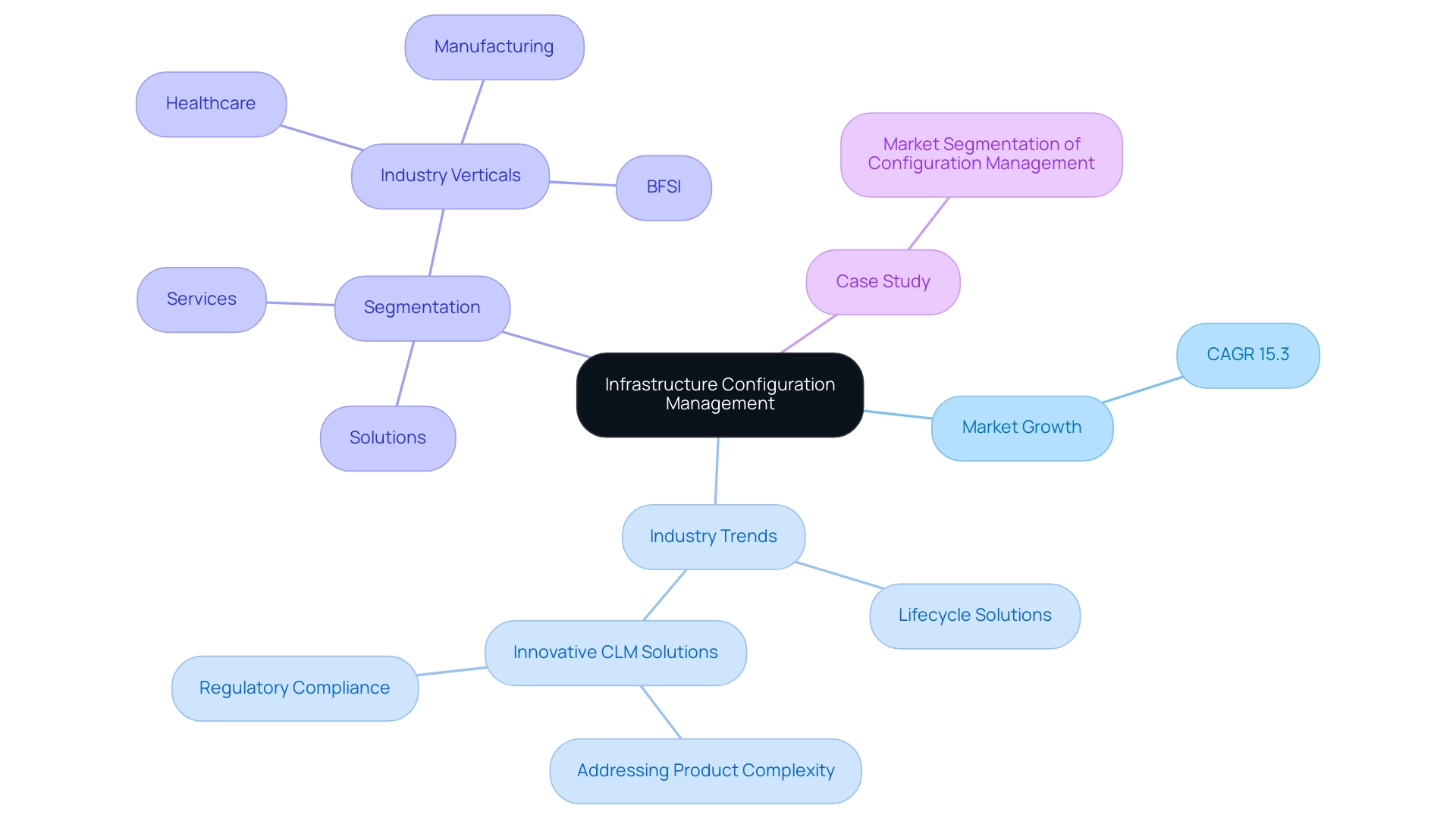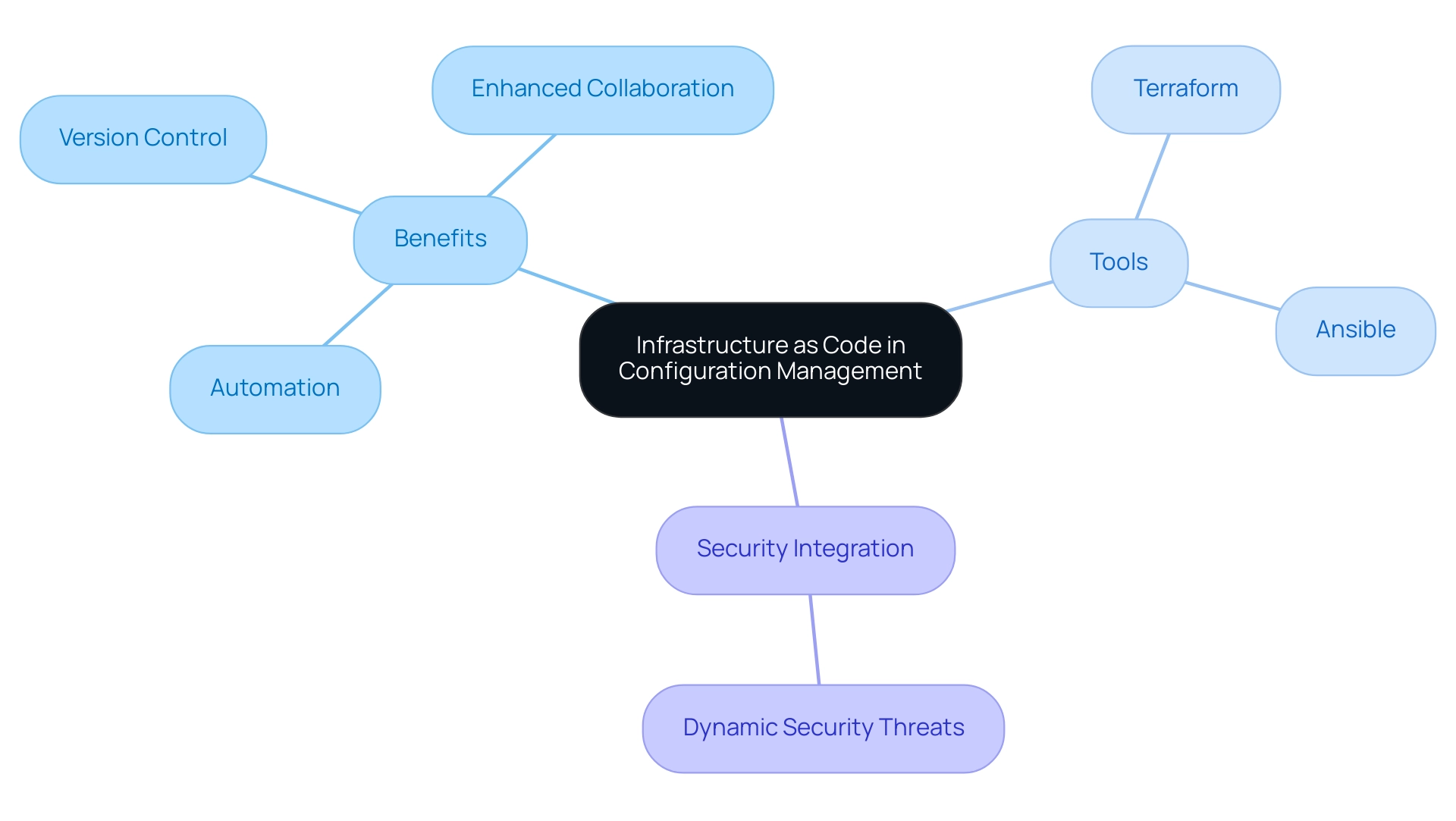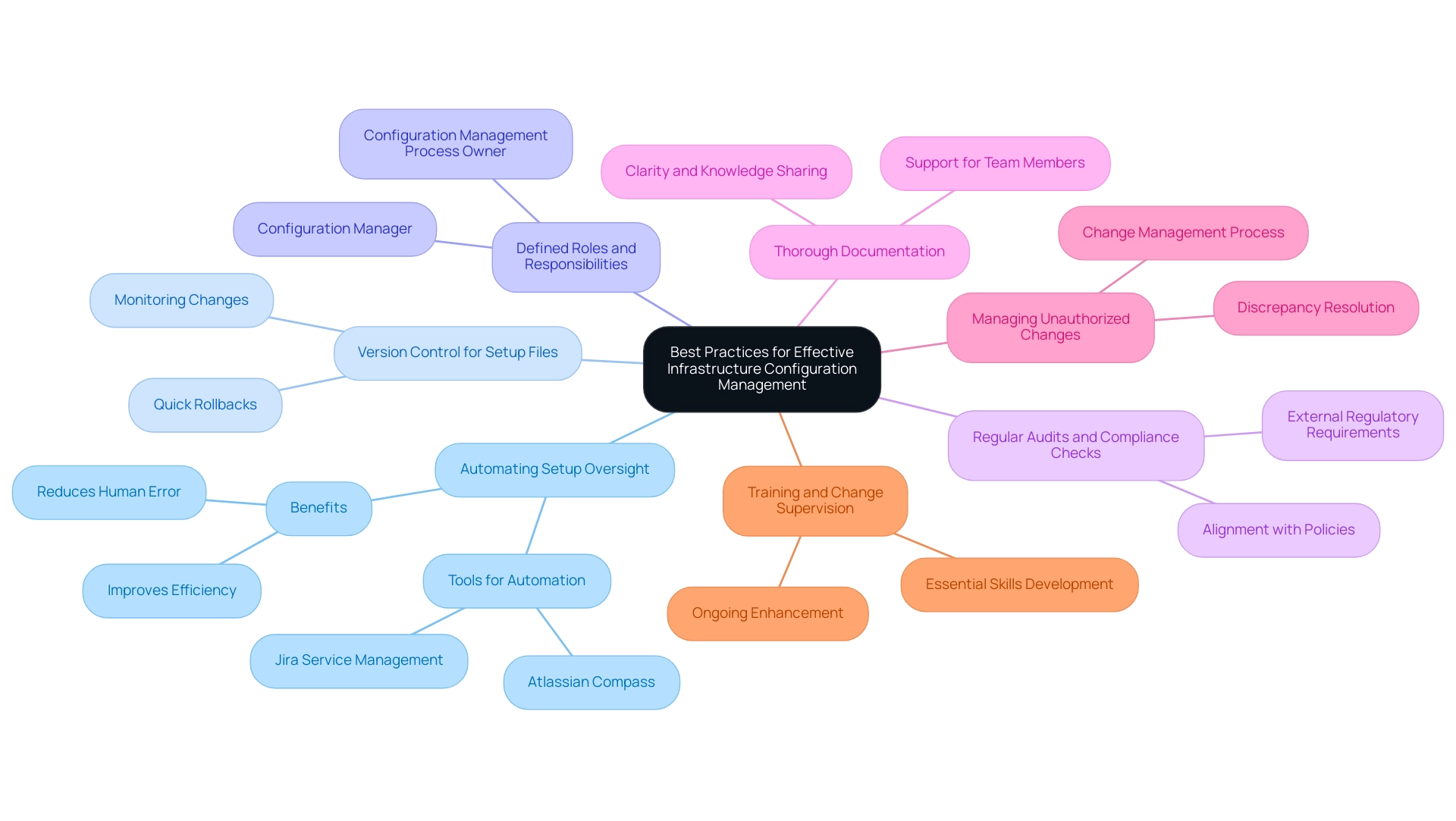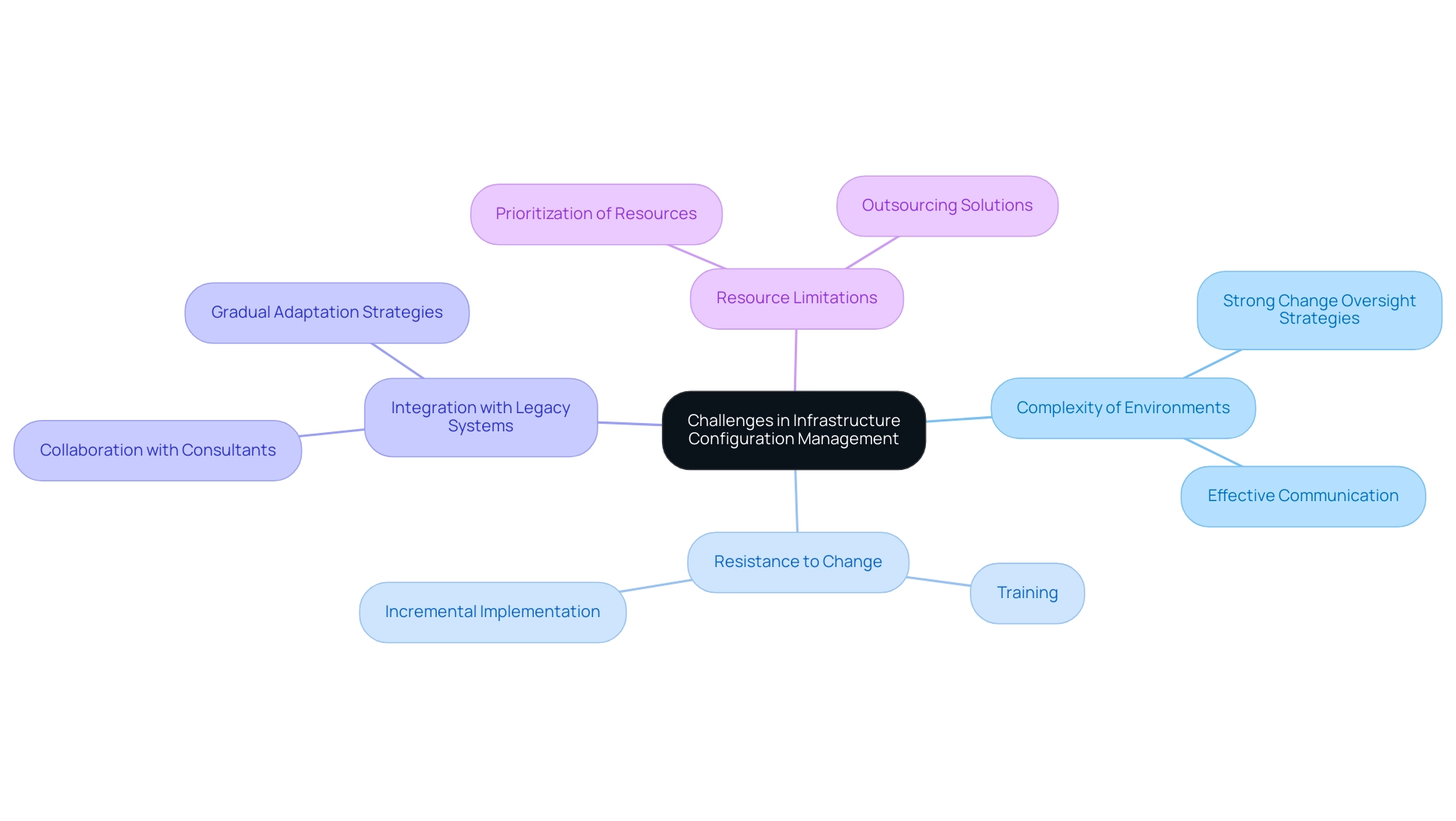Introduction
In the ever-evolving landscape of information technology, Infrastructure Configuration Management (ICM) has emerged as a cornerstone for organizations striving to maintain operational excellence. As businesses increasingly rely on complex infrastructures to meet their dynamic needs, the importance of ICM becomes paramount, ensuring that systems function consistently and securely throughout their lifecycle.
This article delves into the critical aspects of ICM, exploring its role in aligning infrastructure with business objectives, the transformative impact of Infrastructure as Code (IaC), and the best practices necessary for effective management. Additionally, it addresses the challenges organizations face in implementing robust configuration strategies and provides insights into overcoming these hurdles.
By prioritizing ICM, organizations can enhance service delivery and drive efficiency, ultimately positioning themselves for success in a competitive marketplace.
Understanding Infrastructure Configuration Management
Infrastructure configuration management (ICM) is a critical discipline aimed at maintaining the consistency of a system’s performance and functional attributes in alignment with its requirements, design, and operational data throughout its lifecycle. This entails the organized oversight of alterations to the setup of system elements, including servers, networks, and applications. Effective infrastructure configuration management is essential for entities seeking to minimize system downtime, enhance security, and improve overall service delivery.
As the market for setup oversight is anticipated to expand at a compound annual growth rate (CAGR) of 15.3% throughout the forecast period, it is evident that infrastructure configuration management (ICM) is progressively recognized as a vital component for aligning infrastructure with business goals. This alignment facilitates smoother operations and enables organizations to respond swiftly to evolving business needs. A significant trend in the setup oversight market is the adoption of innovative Lifecycle Solutions (CLM) that address product complexity and regulatory compliance, reflecting the major trend in the industry.
Moreover, the segmentation of the setup oversight market—by components such as solutions and services, and by various verticals like BFSI, healthcare, and manufacturing—highlights the need for tailored strategies that cater to specific industry requirements. For instance, the case study on market segmentation illustrates how companies can apply targeted strategies according to their particular operational requirements, thus improving the efficiency of their setup efforts. Additionally, examining the financial performance of Oracle Corporation provides insight into the competitive landscape of the market, underscoring the importance of ICM in driving business success.
By prioritizing infrastructure configuration management, entities can ensure their framework effectively supports their operational goals, driving both efficiency and reliability.

The Role of Infrastructure as Code in Configuration Management
Infrastructure as Code (IAC) serves as a crucial component of modern infrastructure configuration management techniques, transforming how entities provision and oversee their resources. By utilizing code for system oversight, IAC promotes automation and guarantees uniformity through infrastructure configuration management across various environments. This approach enables organizations to manage systems through infrastructure configuration management in a manner similar to application code, thereby facilitating version control of configuration settings.
As a result, tracking changes and executing rollbacks become streamlined processes. According to the latest findings from the DevOps Pulse 2023 report, 72% of respondents are integrating security with observability and monitoring, a practice that aligns with infrastructure configuration management principles by effectively addressing dynamic security threats. This unification is crucial as it promotes a proactive stance in managing security risks in an increasingly complex IT landscape.
Tools such as Terraform and Ansible exemplify the practical application of infrastructure configuration management, showcasing its capability to simplify deployment and management tasks. These tools not only mitigate manual errors but also enhance deployment speed, thereby improving operational efficiency. Furthermore, the adoption of IAC fosters a collaborative culture among development and operations teams.
As one expert notes,
- 'Ensure all voices are heard in team problem-solving with these strategies.
- Promote equal participation and encourage feedback for better collaboration.'
This collaborative environment ultimately results in the development of more robust and agile IT systems.
Additionally, insights from the case study titled 'Diverse Tool Usage in DevOps Teams' illustrate how entities leverage multiple tools simultaneously, emphasizing the complexity and diversity of tools necessary for successful DevOps implementation alongside infrastructure configuration management. As enterprises progressively adopt infrastructure configuration management, the uptake rates are anticipated to increase notably during 2024, underscoring its essential role in contemporary IT system oversight.

Best Practices for Effective Infrastructure Configuration Management
Efficient oversight of infrastructure configuration management relies on the implementation of various best practices that are vital for enhancing IT services. Firstly, automating setup oversight is essential; entities should utilize tools like Atlassian Compass integrated with Jira Service Assistance to streamline the setup process, thereby reducing human error and improving efficiency. Statistics show that firms following ITIL’s best practices, especially those using a Management Database (CMDB), encounter 50% fewer downtime incidents, highlighting the importance of automation in ensuring operational continuity.
Additionally, applying version control for setup files enables entities to carefully monitor changes and supports quick rollbacks when needed, which is essential for preserving system integrity. Clearly defined roles and responsibilities are essential for effective Configuration Management; roles such as Configuration Management Process Owner and Configuration Manager ensure that processes are followed and that accountability is maintained. Regular audits and compliance checks are also essential; organizations should routinely evaluate setups to ensure alignment with both internal policies and external regulatory requirements.
Thorough documentation plays a pivotal role in management as well. Keeping thorough documentation of all setups and changes encourages clarity and supports effective knowledge sharing among team members. Vibhu Jain, Product Manager at CloudEagle, aptly summarizes this need, stating,
With our capabilities, we will help you maintain visibility, ensure compliance, and optimize your settings effortlessly.
Lastly, a practical approach to managing unauthorized changes is illustrated in the case study on Control Management, where unauthorized changes are directed to Change Management, ensuring that all changes are authorized and discrepancies are addressed promptly. Investing in training and change supervision is essential. Providing employees with the essential skills and knowledge of the tools and procedures involved in setup fosters an atmosphere of ongoing enhancement.
By following these best practices, entities can significantly boost their infrastructure configuration management abilities, ultimately leading to enhanced service delivery and greater operational resilience.

Challenges in Infrastructure Configuration Management
Oversight in infrastructure configuration management is crucial for enhancing IT environments, but it poses a range of challenges that entities must handle efficiently. The complexity of environments is a primary obstacle; as companies grow, effective infrastructure configuration management across varied settings can result in inconsistencies, which statistics indicate significantly hinder success rates in setup oversight initiatives. In 2023, entities that unified their application and data security defenses reported global benefits, highlighting the importance of cohesive strategies in overcoming these challenges.
Furthermore, resistance to change is common, as employees frequently hesitate to embrace new tools and processes, thereby undermining the potential advantages of system organization. Integration with legacy systems poses another significant obstacle to infrastructure configuration management, complicating the implementation of modern practices and leading to further inefficiencies. Furthermore, resource limitations can restrict the capacity of entities to effectively implement thorough infrastructure configuration management oversight strategies.
To address these obstacles, entities should focus on strong change oversight strategies that enable smoother transitions in infrastructure configuration management. Investing in training is critical, as it equips employees with the necessary skills to embrace new methodologies. Incremental implementation approaches can also be beneficial, allowing for gradual adaptation to evolving business needs.
The significance of effective communication and collaboration cannot be overstated; as highlighted by a case study on the importance of infrastructure configuration management, entities that engage external consultants can leverage specialized knowledge to navigate these complexities. By nurturing settings where teamwork flourishes, organizations can innovate and apply solutions that effectively handle the complexities of management. This is echoed by feedback from one of the largest companies in the defense industry, which stated,
'Thank you for sending the market report and data.
It looks quite comprehensive and the data is exactly what I was looking for. I appreciate the timeliness and responsiveness of you and your team.'
This underscores the significance of timely and responsive communication in addressing challenges related to infrastructure configuration management.

Conclusion
Prioritizing Infrastructure Configuration Management (ICM) is essential for organizations aiming to achieve operational excellence in today's complex IT landscape. As outlined in this article, ICM serves as a foundational discipline that ensures the consistency of system performance while aligning infrastructure with business objectives. The integration of Infrastructure as Code (IaC) has revolutionized configuration management by enabling automation, enhancing collaboration, and streamlining processes, which are vital for maintaining efficiency and reliability.
Effective management practices, such as:
- Automation
- Version control
- Thorough documentation
are critical for organizations to optimize their IT services and minimize downtime. Additionally, addressing the challenges associated with ICM—such as resistance to change and integration with legacy systems—requires a proactive approach that includes robust change management strategies and ongoing training. By fostering a culture of collaboration and continuous improvement, organizations can navigate these hurdles successfully.
In conclusion, the significance of ICM cannot be overstated. Organizations that embrace best practices and innovative solutions position themselves to thrive in a competitive marketplace, ultimately enhancing service delivery and operational resilience. As the demand for effective configuration management continues to grow, investing in ICM will be a decisive factor in achieving long-term success and adaptability in an ever-evolving technological environment.




